Tupiq facts for kids

The tupiq (pronounced TOO-pik) is a special tent traditionally used by the Inuit people. It's made from the strong skins of seals or caribou. These tents were very important for Inuit families as they traveled across the land.
What is a Tupiq?
The word tupiq comes from the Inuktitut language, which is spoken by the Inuit. For many years, it was the main type of portable home for the Inuit people. These tents were usually made from the tough skins of seals, especially the large bearded seals, or sometimes from caribou skins.
To make a tupiq, an Inuit hunter needed to catch several bearded seals, which are called ugjuk (OOG-jook). A smaller tent, perhaps for a single hunter, might use five seal skins. A larger family tent needed ten or more seal skins to be big enough for everyone.
How a Tupiq is Made
Making a tupiq was a careful process. First, after a bearded seal was caught, its thick layer of fat was scraped off the skin. Then, the skin was stretched out to dry. Once the skins were ready, Inuit women would sew them together very carefully to create the tent's shape.
Sometimes, extra layers were added to make the tupiq warmer. People would lay heather plants on top of the outer skin. Then, another skin would be wrapped around the tent to hold the heather in place, creating good insulation.
Life in a Tupiq
The tupiq was used when Inuit families were traveling on land, not on the sea ice. It was easy to take down and set up again, which was perfect for people who moved often. A well-made tupiq could last for several years.
When winter arrived, and the tupiq was not being used, it had to be stored safely. It was very important to keep the tent skins away from dogs, who might chew on them.
The Inuit had different homes for different seasons:
- Summer: The tupiq was used as a shelter during the warmer months.
- Fall: As it got colder, Inuit families moved into a qarmaq. A qarmaq was a type of house made from sod (earth and grass) or stone. The tupiq skins were often used as the roof for these qarmaq homes.
- Winter: When there was enough snow, the Inuit built igluit (IG-loo-eet), which are snow houses. They lived in these warm snow homes during the coldest parts of winter.
- Spring: As the weather warmed up and the igluit began to melt, families would move back into their portable tupiit.
Tupiq Today
The tupiq was a very important part of traditional Inuit life. However, it is rarely used today. Most Inuit now use modern canvas tents, which they call tupikhaq (TOO-pik-hak). These new tents are still used for camping and traveling, continuing the tradition of portable homes.

